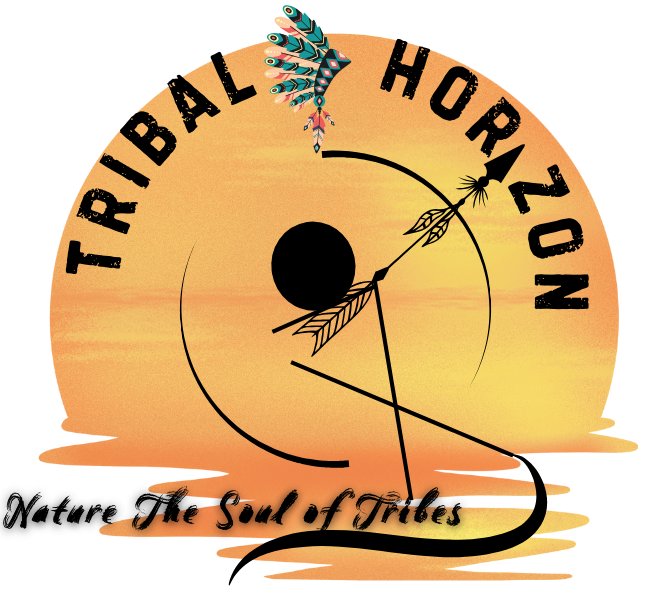The Gond tribes are one of the largest indigenous groups in India, known for their rich history and vibrant culture. They live in central India, where the forests, hills, and rivers shape their lives. The Gond way of life combines nature, customs, and community. They express their beliefs and legends through colourful Gond paintings, folk songs, and energetic dances.
The Gond people have a proud history of bravery, highlighted by Rani Durgavati, a queen who fought fiercely against the Mughal army. She represents the resilience and spirit of her people, which they continue to celebrate today. Today, the Gond tribes continue to hold onto their unique religious practices, festivals, and traditions. They keep alive a cultural identity that has lasted for centuries. This article explores the history, society, art, and modern challenges of the Gond tribes, demonstrating that Gondwana is not just a geographical location; it is a rich world of culture, resilience, and timeless stories.
Who Truly Are the Gond Tribes? Beyond Labels and Numbers
The Gond people are India’s largest tribal group, living mainly in central India and numbering in the millions. However, they are much more than just a statistic. The Gond tribes and other tribal communities represent a rich culture that has preserved its customs and traditions across forests, hills, and rivers for thousands of years. To understand the Gond people, it’s important to see how closely their lives connect with nature, community, and memory.
Every story shared by the fire, every colourful cave painting, and every folk dance performed to drumbeats reflects their beliefs and values. Their identity goes beyond numbers; it comes from their language, religious rituals, folk songs, and respect for the land. The Gond castes are not just a community; they show a culture of strength and resilience. Their identity proves that true identity is about more than labels; it is a living legacy.
History of the Gond Tribes: Beyond Myths and Memories
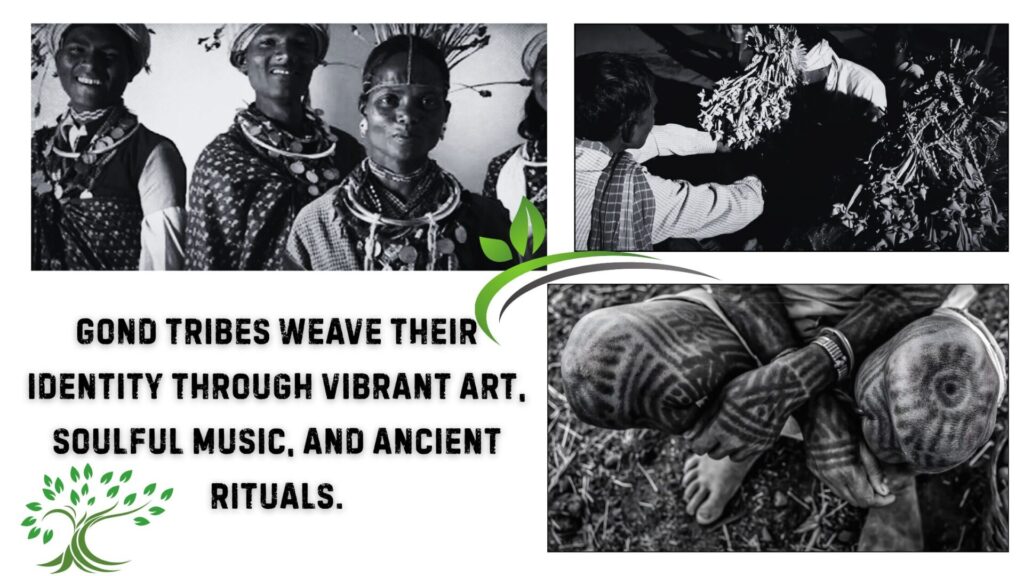
The Gond tribes have a rich history that goes beyond dates and dynasties. Their story is filled with legends, memories, oral traditions, folk songs, and recorded history. The Gond people ruled Gondwana and resisted outside forces, significantly influencing the culture and politics of central India. Unfortunately, their contributions are often overlooked in mainstream accounts, and historians have not fully recognised their importance.
Gondwana’s Earliest Footprints: Where Myth Meets History
Gond folklore dates back to before written records. It is found in myths, stories passed down orally, and the land of central India. Anthropologists believe that the Gonds have lived in these forests and hills for thousands of years. For the Gonds, history is more than archaeology or written language; it includes the stories told by elders, the songs sung during festivals, and the sacred lands they still call home. In Gond beliefs, the land of Gondwana is not just a place to live; it is the center of their world. Rivers, mountains, and forests are not just resources; they are living beings connected to the Gonds’ lives.
The Gonds worship ancient clan totems and gods like Farsa Pen and Bada Dev, and they hold seasonal religious rituals.
This shows that they believe humans, spirits, and nature all share a connection. The history of Gondwana lies where Gond symbols, myths, and memories meet. Here, the lines between history and belief become unclear. The identity of the Gond people began to form long before kingdoms or empires arose around them.
Rise of Gond Kingdoms in Medieval India
In the early 14th century, the Gond tribes left the forests and hills to shape the political landscape of central India. Unlike other tribal communities that mostly lived in small villages, the Gonds built kingdoms, forts, and dynasties, leaving a significant impact on the medieval map of India. The Gondwana region had four main Gond states: Garh-Mandala (near Jabalpur), Devgadh (in Chhindwara), Chanda (now known as Chandrapur in Maharashtra), and Kherla (in the Betul district of Madhya Pradesh). These were not small tribes; they were powerful states with armies, trade connections, and administrative systems.
Gond rulers constructed forts, built temples, and encouraged agriculture, which provided stability and a sense of identity for their people. One famous figure from this time is the tribal warrior queen Rani Durgavati (1524–1564) of Garh-Mandala. When Mughal Emperor Akbar’s forces attacked, she chose to fight rather than surrender. She showed unmatched bravery in battle and fought until her last breath, becoming a lasting symbol of courage, sacrifice, and Gond pride.
People still remember her story in folk songs and tales, celebrating her as a source of inspiration. The rise of the Gond kingdoms shows an important truth: the Gonds were not just forest dwellers; they were builders of states, warriors, and visionaries. Their kingdoms demonstrate that tribal identity can combine tradition and governance, creating a legacy that still resonates in central India.
The Gond Worldview: Family, Festivals, and Social Harmony
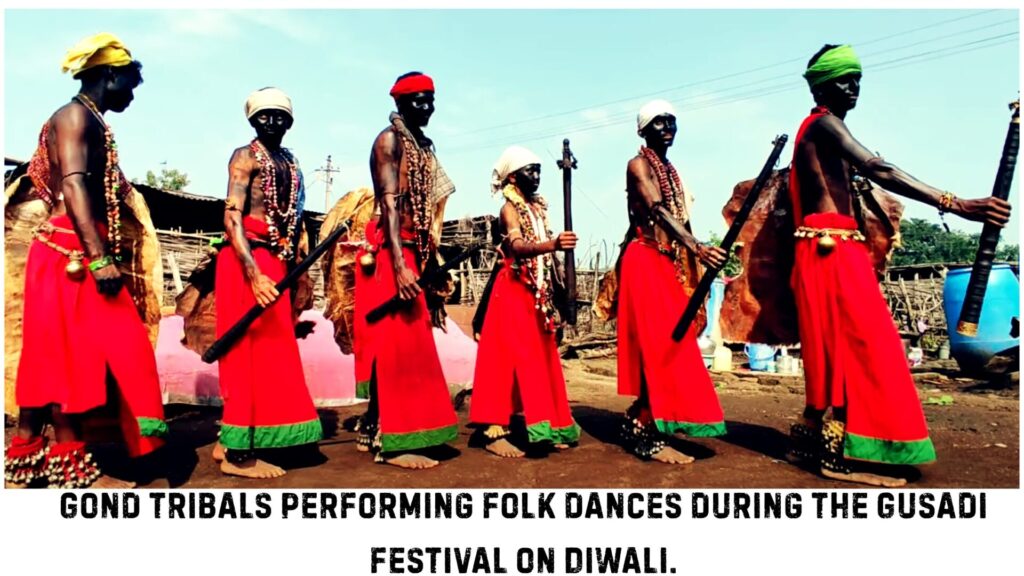
For the Gond people, life is a continuous flow that combines work, worship, and leisure. Family, community, nature, and faith are all connected and balanced. They believe that harmony within the family and society is just as important as harmony with water, forests, and land.
Family and Clan Structure
The Gond tribal society is made up of clans called gotras. Each clan has a totem, which can be a plant, an animal, or a natural symbol. These clans control marriage, ensuring that people do not marry within the same lineage. The Gond family system values respect for elders, group decision-making, and shared responsibilities. Unlike individualistic cultures that focus on gender equality, the Gond people emphasize belonging and unity.
Festivals that Celebrate Nature and Community
Gond tribes’ festivals go beyond religious rituals; they show a strong connection to nature. Each tribe sees nature as a father figure. For example, the Karma festival celebrates the spirits of trees and fertility. The Madai festival is a lively village gathering with folk dances, music, and offerings to local deities. Each season features a festival linked to the agricultural cycle, reflecting its spiritual importance. The tribes value agricultural festivals highly, and during these events, grains like rice are especially important. This shows that the Gond people view existence and celebration as the same.
Music, Dance, and the Joy of Togetherness
Gond gatherings, like other tribal gatherings around the world, always include music and folk dance. These elements are a vital part of their identity. Traditional instruments such as the dhol, mandar, and flute create the rhythm for group dances like sayla, dandari, and karma nach. These performances do more than entertain; they also express messages from nature. They share stories about clan deities, ancestors, and heroic struggles. Through these art forms, the Gond people build their identity and teach values to the younger generation.
The Gond Leaders and Their Legacy: Messages Across Time
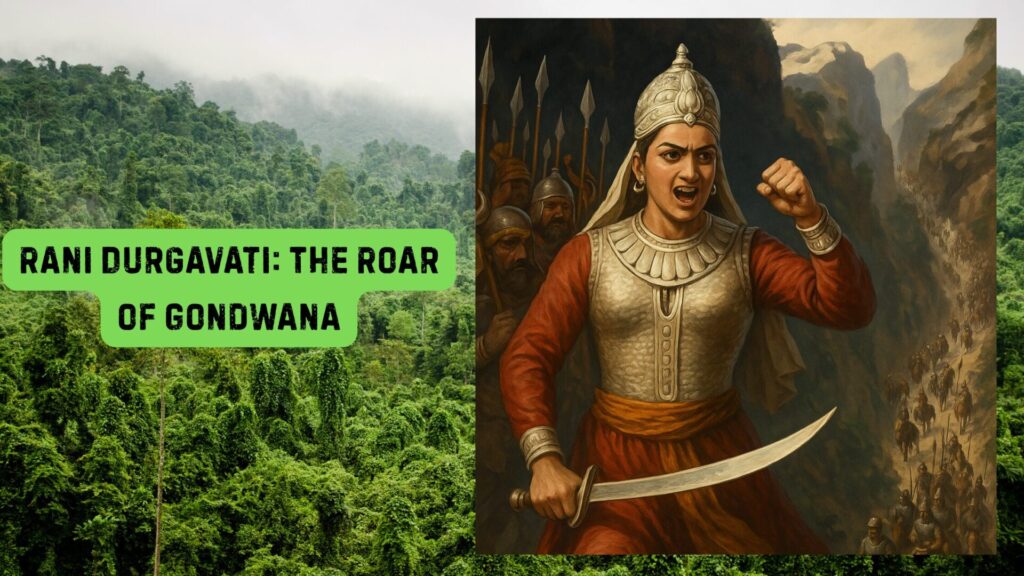
The Gond tribes community is known for its art and culture, as well as for the heroes and leaders who protect their land and traditions. Their folk tales are shared across generations and convey important messages about courage, justice, and resilience. Leaders play a key role in keeping these traditions alive.
Rani Durgavati – The Warrior Queen of the Gonds
Queen Durgavati (1524-1564) is the most famous leader among the Gond tribe. As the queen of Garh-Mandla, she fought against the Mughal army led by Asaf Khan. Instead of giving up, she chose to sacrifice her life because she valued freedom over being a slave. Durgavati became a symbol of bravery and self-respect. Her message was clear: freedom and dignity matter more than life itself.
Gond Kings of Garha-Mandla and Deogarh
Before colonial powers arrived, the Gond states of Garh-Mandla, Devgadh, and Chanda were strong and successful. Leaders like Hirade Shah and Bakht Buland Shah expanded their lands, encouraged trade, and protected their people. They practiced inclusive leadership that focused on justice and the well-being of the community.
Tribal Chiefs and Local Guardians
In addition to the great kingdoms, the Gond tribes were protected by numerous local chieftains and village elders. They maintained harmony, protected the forests, and ensured that traditional customs survived even in times of political upheaval. These unknown leaders were the backbone of Gond resistance and cultural preservation.
Messages that Still Inspire
The messages from Gond leaders, like the courage of Durgavati and the wisdom of Gond kings, are still important today. These messages include: – Unity in tough times – Respect for water, land, and forests – Sacrifice for the good of the community – Justice instead of dominance.
These values also connect with other tribal leaders across India. For example, Alluri Sitarama Raju led the Koya tribes in the Rampa Rebellion (1922-1924) against British exploitation in the Eastern Ghats. Though he was not a Gond, his fight shows the same spirit of Gond leadership a refusal to accept injustice.
Gond tribes Religion and Beliefs: The Sacred Bond with Nature
The Gond tribal community sees religion as connected to nature. They do not just worship in temples or read scriptures; their beliefs are part of the forests, rivers, animals, and ancestral spirits. Unlike many religions, the Gond people do not follow a specific faith. Instead, they view the laws of nature and the need to protect them as their religion. This perspective shapes their way of life and culture. Their belief system is one of the oldest spiritual traditions in India and is rooted in animism and the worship of natural forces.
The Spirit of Animism and Nature Worship
The Gond people see the natural world as a sacred partner in life, not just a resource to use. They believe that trees, hills, rivers, and animals have spirits that protect and guide them. Before cutting down a tree or hunting an animal, they perform rituals to ask for forgiveness, showing their deep respect for nature. This way of thinking promotes a sustainable way of life that modern society can learn from. They also honor and thank the gods after a hunt or when their work is finished.
Totems and Clan Identity
Each Gond clan, or gotra, in the Gond tribes has a totem, usually an animal, plant, or natural symbol. Clan members do not harm this totem because it represents their beliefs and provides protection. For example, a clan connected to a tiger will not kill the animal, ensuring its safety for future generations. This practice combines religion, culture, and ecology to help manage natural resources effectively.
Festivals as Expressions of Faith
Gond festivals are more than just social events; they are forms of worship. These celebrations show gratitude to nature. For example, the Karma Utsav honors fertility and the spirit of trees, while the Madai Mela brings villages together for devotion, dancing, and music. Each festival highlights the belief that faith and joy should go hand in hand, and that living in harmony as a community is a way to worship.
Badadev: The Supreme Deity of the Gond Tribes and Their Faith
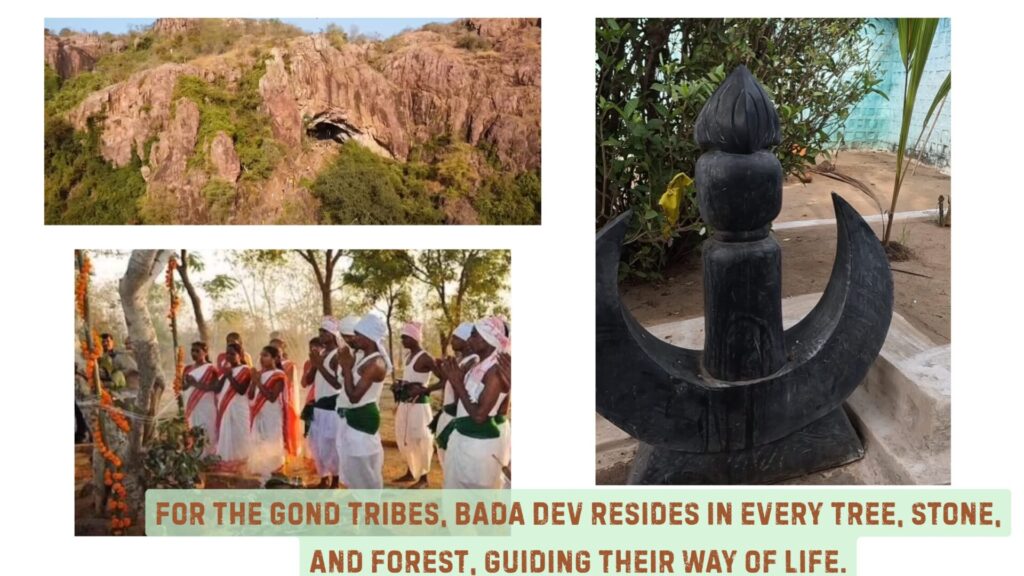
Bada Dev, also called Fada Pen and Parsa Pen, is the most vital figure in Gond tribal society. He is worshipped as the supreme force of the universe, the father of all powers, and the eternal protector of life. For the Gond tribes, Badadev is not only a god but also the living energy of nature, tied to the five elements: earth, sky, water, air, and fire. His worship embodies the balance of the world and the very existence of all beings.
The Formless and Eternal Power of Badadev
Badadev is seen as formless, immortal, and eternal. While all living things eventually perish, Badadev remains unchanging, linked deeply with the five essential elements that create and sustain the universe. This is why the number five holds a sacred place in Gond culture.
Salla Gagra: The Dual Energies of Creation
In Gond tradition, Badadev is also known as Salla Gagra, which reflects the union of Pitru Shakti (father energy) and Matru Shakti (mother energy). These two forces symbolize the balance of masculine and feminine, without which no life could exist. The light from these powers is believed to give birth to the seven sagas, shaping Gond cosmology.
The Sacred Saja Tree and Badadev’s Worship
The Saja tree is considered the earthly abode of Badadev. With its five panels representing the five elements, it is honoured as sacred in Gond rituals. The tree is also known as the “thirst-quenching tree” because its branches provide water drops during summer heat. For the Gond people, the Saja tree is more than just a plant—it is a living symbol of Badadev’s divine energy and their bond with nature.
Gotul: The Sacred Institution of Learning in Gond Culture
Outsiders often misunderstand Gotul, but for the Gond tribes, it is a sacred institution. Information about Gotul is often presented in a way that can seem absurd, but the reality is quite different. This misunderstanding largely stems from the fact that those who have attempted to understand it did not grasp the Gondi dialect. Much of what they did comprehend was then communicated to the wider world, leading to misconceptions.
Additionally, the tribal community tends to be cautious and does not easily trust outsiders, which often results in incomplete information being shared. Gotul serves as a place where young boys and girls learn about discipline, responsibility, and the values of community life. Contrary to the myths that surround it, Gotul functions as a cultural institution that prepares the youth for adulthood, ensuring that traditions, skills, and respect for nature are passed down.
The True Purpose of the Gotul
The primary purpose of Gotul is to train the younger generation to become responsible members of society. It teaches them how to live in harmony with their community, respect water, land, and forests, and preserve the traditions of their ancestors and their culture.
Equality and Discipline
In the Gotul, boys and girls participate on equal terms. Both receive training in farming, hunting, folk songs, dances, and rituals. This balance of freedom and responsibility fosters unity and social harmony in Gond society.
A Cultural Hub of the Gond Tribes
Gotul serves as the heart of Gond culture. It is a place where traditional folk songs are sung, festivals are celebrated, group dances are performed, and various religious customs and rituals are practiced. In many ways, it functions like a “living university,” connecting the youth with the spiritual and cultural roots of the Gond community.
FAQ
Who are the Gond tribes of India?
The Gond tribes are one of the largest Adivasi (indigenous) communities of India, mainly found in Madhya Pradesh, Chhattisgarh, Maharashtra, Andhra Pradesh, and parts of Odisha.
What is the origin of the Gond tribes?
The Gond people originated in the Gondwana region thousands of years ago. They have a deep connection to forests, irrigated agriculture (land), and ancient subsistence traditions.
What language do the Gond tribes speak?
Most Gond tribes speak the Gondi dialect, although many also use regional languages such as Hindi, Marathi or Chhattisgarhi. But the Gondi dialect is their primary identity.
What is unique about Gond art and culture?
The Gond tribes are world famous for their Gond paintings, folk songs, and group dances like Karma Nach and Sayla, which reflect their mythology, festivals, and connection with nature.
Who is Badadev in the Gond tribes’ faith?
Badadev, also known as Baradeo or Bada Dev, is considered the supreme deity of the Gond tribes.
What is the cultural significance of Badadev for the Gond tribes of India?
For the Gonds, Badadev symbolises spiritual strength, justice, and ecological balance. His worship connects them to their ancestors, their land, and the natural world.
Conclusion
The Gond tribes are more than just a historical community; they represent the heartbeat of the land. Each painting, every rhythm of their drums, and the vibrant festivals they celebrate open a doorway to a cherished, yet often forgotten, home. They haven’t merely survived the trials of time; they have taught the world the art of living in harmony with the earth, with respect for one another, and with unwavering courage in the face of life’s storms.
For centuries, society has attempted to reduce them to mere labels: “tribals,” “backwards,” “forgotten.” Yet the truth is that the Gond tribes hold an entire universe within them: languages that resonate with the whispers of the forest, rituals that pay homage to the soil, and a spirit that remains unyielding. When we listen closely, we don’t just hear their narratives; we rediscover our own lost bond with nature and with ourselves. In essence, the Gond tribes are not relics of a bygone era. They are living messages, softly urging us even today: Respect the land. Protect your people. Carry your stories forward. Their wisdom invites us to connect with our roots and to cherish the world around us.
Your feedback means a lot to us.
If you have any questions, suggestions, or concerns feel free to leave a comment below.We’re here to listen, grow, and improve together.
